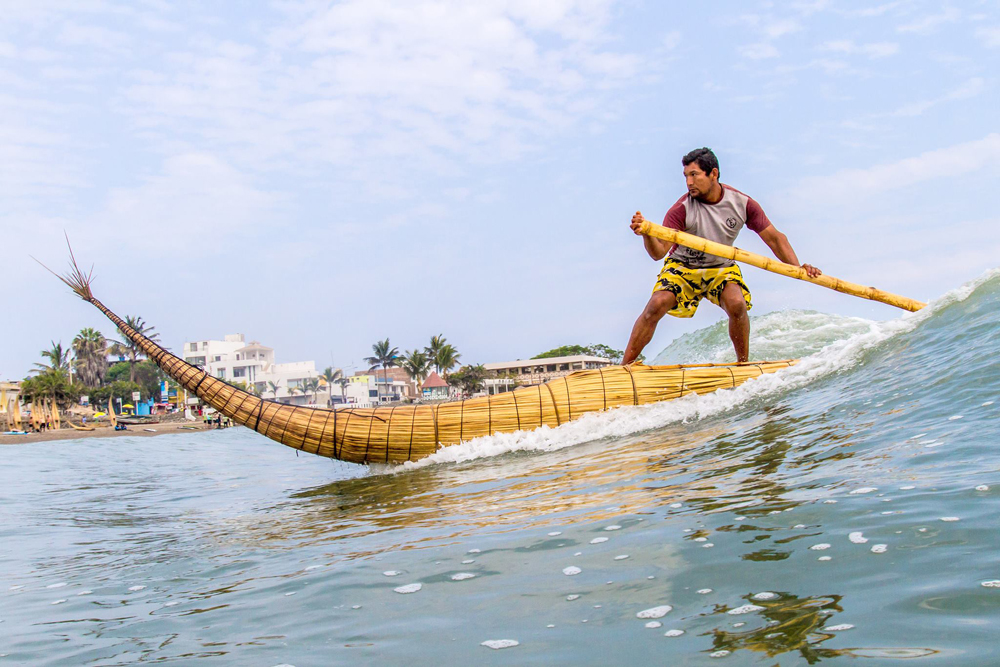Caballitos at Bondi: The oldest form of surfing comes to Australia's best known beach
In the history of surfing, Peru is an inconvenient truth. The official narrative is that surfing was invented by Hawaiians; it was likely practiced by children as early as 2,000 AD, but scholars note that by 1,200AD surfing in Hawaii was practiced by adults as well as children. For many years this was the accepted, unarguable history of surfing.
Yet in recent years the waters have become muddied. It's now obvious that if surfing's official history is to endure then 'surfing' has to have a clearer definition, and the reason is due to Peru. Over the last thirty years Peruvian surfer and 1965 World Champion, Felipe Pomar, has been on a quest to have Peru's surfing history recognised. His cause has been aided by archaeological discoveries in the north of Peru.
In the ancient Peruvian city of Caral, known by some anthropologists as “The Mother of All Civilisations”, lines of swell are carved into rock walls. A two-thousand-year-old frieze shows a deity riding across the night sky on a reed board, while a ceramic set displays two Peruvians straddling their reed boards. The artifacts at Caral date back to 2,600 BC, long before Hawaii was even inhabited.

The Peruvian reed board, otherwise known as the caballito or 'little horse', is suspected as having been invented around 3,000BC in northern Peru near Huanchaco. It was used by traders to move goods between coastal villages and by fishermen to reach deeper water. In both instances the caballito had to be ridden back through the surf when returning to shore.
But was it a tool for commerce or a toy for play? That's the distinction used by surfing scholars adamant that surfing began in Hawaii. Peruvian fishermen may have been riding waves for millennia before Hawaiians set foot on a surfboard, yet it was the Polynesians who shifted surfing from a utilitarian function to a recreational pursuit, which is how we understand it now.
Unperturbed, Felipe Pomar and a small band of Peruvian surfers have been pressing home the point that this branch of surfing history needs wider recognition and to that end they're currently in Australia touring the east coast.
One of the party is Carlos Ucanan Arzola, better known as 'Huevito'. Huevito comes from Huanchaco and his family extends back 500 generations pre-dating the Spanish conquest.
“I'm a Huanchaco fisherman, like my ancestors,” says Huevito. “My caballito de totora is my boat that provides for my livelihood and family.”
The caballito is made from totora – known outside Peru as Californian Bullrush - which is harvested and then allowed to dry over a few months. When the reeds are dry enough they're bunched together, lashed by rope, and then shaped to give the distinctive prow that allows them to crest a wave with control. Hundreds of reeds are used in each caballito.
“It only takes me one hour to build a caballito de totora and it's usually done by two skillful people,” says Huevito.
As the caballito is made of organic matter it decomposes very quickly. Traditionally a caballito would reman seaworthy for approximately two months before the totora becomes too soft, at which point another would be made.
Huevito estimates he's made over a thousand caballitos in his lifetime. “I built my first one when I was twelve. I’m 43-years-old, and on average I build three or four caballitos per month.”
Though he uses it for work, Huevito sometimes rides his cabaillito for fun. “The biggest wave I've ridden [on my caballito] would be 8 foot. My local break Huanchaco can handle big 10 foot waves and is a left-hand point. It suits me as I’m a goofy foot, though I can surf the caballito both ways.”
Tomorrow morning Bondi surfers will get the opportunity to see Huevito ride his caballito both ways. It's the first time a caballito has ever been ridden in Australia and Huevito is making one especially for the occasion. At 7:30am the Peruvian party including Huevito and Felipe Pomar, as well as Rabbit Bartholomew, Cheyne Horan, and Andy Mackinnon, will assemble at Lush Cafe, Bondi Pavillion, with Huevito starting his display of Peruvian wave riding at 8am.
Work or fun? Who cares. Everyone is welcome to come and watch the oldest known form of surfing.
Edit 24/2: Check the photos of Huevito constructing and surfing his caballito at Bondi.


Comments
I went to Huanchaco once; saw these sb's in action - pretty cool. I did notice the modern versions had a foam insert of some sort for the rider to sit on, rest their fishing nets etc. I recon its fantastic the Peruvians are appropriately recognised for their place in history. Its no surprise they were early surfers either, their coast has macking waves from start to finish. Also I think I'm right to say Bob Pike was the 1st Aussie to win an international contest, which was in Peru? If so, then our respective nations have longstanding connections as surfers too.
SUPs the original surfcraft??
It's a bitter pill to swallow, eh Max?
Certainly and 'inconvenient truth' haha.